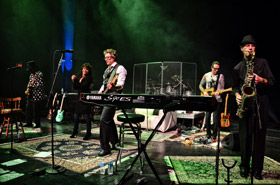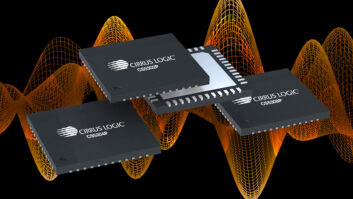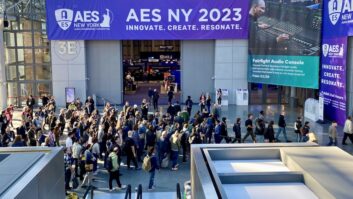
fDeluxe performing during the reunion show
In addition to celebrating its 20th anniversary, Audio Logic Systems handled sound for The Family—under the new name fDeluxe—reunion at Minneapolis’ Loring Theater. Audio Logic owner John Markiewicz and systems tech Ed Coutu brought in a full d&b audiotechnik system comprising J-SUBs, J Infra Subs and C7 mid-high cabs, Q10 front-fills, d&b M6 wedges and two DiGiCo consoles—an SD8 at FOH and an SD10—for handling the group’s wedges and in-ear monitoring systems.
Initially, the input list was quite large with provisions for the 7-piece band—which included the core Family members, plus guitarist Oliver Leiber, Jason-Peterson DeLaire on keys/sax and drummer Mario Dawson—in addition to a 6-piece string section. In the end, it was decided that the inputs needed to be scaled back to 46.
“The initial stage set called for two drums sets because original drummer Jellybean Johnson [playing bass in the new band] was left-handed and wanted to sit in on a few songs,” says Markiewicz. “As things got scaled back, we were only able to use one drum set, with the tech switching kits back and forth on those songs, which were not played in sequence!
“On top of that, I found out a day-and-a-half before the show that KTCA, the Minnesota public TV station, had plans to record the show, so there was the addition of a few extra mics added for that,” he continues. “We agreed that since we were already tracking the show at FOH using an RME MADIFace, we could simply split the feed. I set up KTCA’S engineer, Joe Demko, with a mono feed from my console to sync up in post, which would give them more control over the quality of it. Post-mix engineer Brian ‘Snowman’ Powers was given an additional MADIface interface in monitor world and he tracked the whole show there.
“Going into this, I knew it would be a show that we’d have to fly by the seat of our pants on. The venue was fairly small and the group was very large, and I thought it was best to put everybody on in-ear monitors. Because of budgets, we weren’t able to provide full production for rehearsals, so mixing FOH was going to be very much on the fly on the day of the show. When it was mentioned that Scott Fahey [former production manager for the Gatlin Brothers club at the Mall of America and currently lead audio engineer at Living Word Christian Center] would be doing monitors, I was thrilled; he’s an absolutely phenomenal engineer. I decided to give him the SD10 for rehearsals, which is an excellent desk to mix in-ears on. By getting him the console early, he was able to mix the ears and whatever wedges we ended up using, and I was then able to take his preamp settings and recorded tracks and do a quick virtual soundcheck on my own back at the shop on an SD8. I was able to build scenes for the individual songs, and set up a fair amount of things so that I could get through the show as easily as possible without the benefit of a full production rehearsal. When I got the set list on Friday at load-in, I was able to put the scenes in order, set things such as my gates from song to song, Gain-Track off what Scott got at rehearsals and it allowed me to fine tune each song. It gave me a leg up so when I heard the songs for the first time on the night of the show, I was 80 percent there. And quite literally, it flew from there. We stepped into soundcheck, ran through three to four of the songs, and next thing you know we were into the show.”







